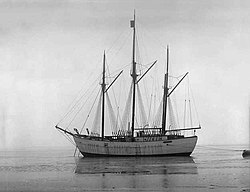 Maud, 1918 | |
| History | |
|---|---|
| Name | Maud |
| Namesake | Queen Maud of Norway |
| Owner | Roald Amundsen |
| Builder | Built in Asker, Norway |
| Launched | June 1916 [1] or 17 June 1917 [2] |
| Owner | Hudson's Bay Company |
| Acquired | 1925 |
| Renamed | Baymaud |
| Owner | Asker, Norway |
| Acquired | 1990 |
| Renamed | Maud |
| General characteristics | |
| Class & type | Oak hulled sailing ship, built for Arctic exploration |
| Tonnage | 292 register |
| Length | 36.5 m (119.75 ft) |
| Beam | 12.3 m (40.35 ft) |
| Depth of hold | 4.85 m (16 ft) |
| Propulsion | 240 hp (177 kW) semidiesel Bolinder engine |
Maud, named for Queen Maud of Norway, was a ship built for Roald Amundsen for his second expedition to the Arctic. Designed for his intended voyage through the Northeast Passage, the vessel was built in Asker, a suburb of the capital, Oslo.
Contents
Maud was launched in June 1916 [1] or 17 June 1917 [2] at Vollen and ceremonially christened by Amundsen crushing a chunk of ice against her bow:
It is not my intention to dishonor the glorious grape, but already now you shall get the taste of your real environment. For the ice you have been built, and in the ice you shall stay most of your life, and in the ice you shall solve your tasks. With the permission of our Queen, I christen you Maud
— Roald Amundsen [1]





